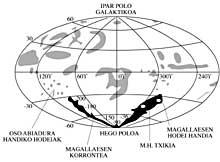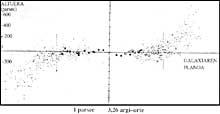Interaction between French and Magellan
There are many reasons to talk about the Clouds in Magellan. They are the example of an irregular galaxy type (Irr I). In it is the incognito supermassive object R136, in which the supernova 1987 A is created, the closest to us in recent centuries. On this occasion, however, these are not the reason why the galaxies closest to the French are mentioned, but their interaction with our galaxy. After giving an overview of the French Way in the previous numbers, in this issue we will analyze the twisting of the slope of the spiral (supposedly created by the Magellanic Cloud).
Until radioastronomy began to develop, it was thought to be pure around the galaxy (outside it). When radio telescopes headed to galactic latitudes outside the French Way plane, numerous clouds of neutral hydrogen (HI) were found. In addition, measuring the characteristic slippage of these clouds 21 cm in length, they allowed to know their radial speeds. H. When Oort (30 years ago) discovered the first clouds, in large galactic latitudes (60>) — galactic latitudes have their origin in the galactic plane; those of the north are positive and those of the south negative — it was observed that they had high velocities (180 km/s) towards the Sun.
According to observations made a few years later, they received the emission of HI clouds approaching the Sun again, but in this case in the galactic south pole and with an approximate speed of 100 km/s. As the different parts of the sky were studied, more complete maps of the HI clouds were made. For example, in 1974 D. Mathewood and his companions found that the clouds found in the south pole were inside a band or tape that began in the Magellanic Clouds and lasted in the sky at 150>. This strip is called Stream of Magellan and seems to be a bridge of matter between these irregular galaxies and the French Way.
Its approximate length is 325 light years and its width varies between 20 and 35 light years by zones. Soon after, under the plane of the galaxy were found other clouds that seemed separate from the Magellanic Current and moved very quickly. Its speeds are approximately 500 km/s. On the other hand, in the northern galactic hemisphere, in the constellation region of Cygnus and Cassiopeia a list of HI clouds was found that climbed to the plane of the first galaxy and then descended and submerged into outer space. In the first image we have a map of the galaxy. In it we can see the clouds mentioned so far and others scattered through space. At some points of the Magellanic Current is the speed with which the surrounding clouds approach the Sun.
Scientists soon began to try to find explanations for all these structures. Undoubtedly, the origin of the Magellanic Current is related to the gravitational interaction between the French Way and the Magellanic Clouds. The latter, hundreds of millions of years ago, are the lost matter after passing or colliding with our galaxy, which has formed the current (Figure 2). It is believed that this interaction has also twisted the disk blades of the galaxy. This effect looks better in Figure 3.
However, this theory presents a great vacuum. Clouds, as seen on the map in Figure 1, are well placed by galactic longitudes and latitudes, but at what distance they are undelimited. That is, its location in figure 2 is not verified, it is only supposed. In the clouds no star has been dated (because they do not exist or are too weak) and therefore we have no reference to contemplate distances. There are many astronomers who also have doubts about the type of interaction, and it cannot be said if there has been a collision or if it has been a close past. When we talk about collision, we have to say, however, that we should not especially imagine a violent phenomenon.
Galaxies can withstand shocks more often than expected, as the average distance between them is 20 times their diameter. By comparison we will tell that between stars around the Sun 10 7 times the average diameter of stars. Therefore, when the shock occurs one galaxy passes through the other, but there is hardly a collision between stars. Of course there is interstellar gas interaction, but the gravity fields of galaxies produce deformations and special structures. Computer simulations have resulted in structures similar to those produced by collisions and interactions between the detected galaxies, but in the case we are concerned we cannot generate concrete results (because they are very sensitive to speed) and for the moment only the radial component of the clouds is known. Therefore, to clarify the problem you need to get more information.
As a final conclusion, we will quote that this makes it clear that to study the shape and dynamics of galaxies are important the galaxies of the environment and their location.
EPHEMERISSUN: Enter Taurus on April 20.
PLANETS:
|








